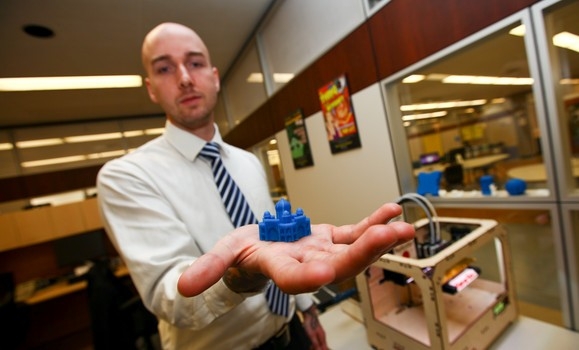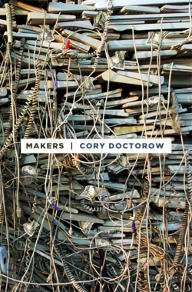Is Google knowledge? (PBS IdeaChannel)
[youtube=http://www.youtube.com/watch?v=aCwLQrJz4Bo&w=420&h=315]
[youtube=http://www.youtube.com/watch?v=aCwLQrJz4Bo&w=420&h=315]
 I just learned that Mike Groenendyk is joining Concordia University Libraries as a fellow business librarian. Michael comes to us from Dalhousie University Libraries, where he’s had quite a bit of impact !
I just learned that Mike Groenendyk is joining Concordia University Libraries as a fellow business librarian. Michael comes to us from Dalhousie University Libraries, where he’s had quite a bit of impact !
In my lazy-yet-mysteriously-efficient-googling, I’ve stumbled on this really interesting project to bring 3D printing to the DAL Libraries, funded by CARL. Watch a YouTube video of a joint presentation at the Access 2012 conference:
[youtube=http://www.youtube.com/watch?v=hWqdQZ1FowY&w=560&h=315]
Also if interest is this video from PBSoffbook on 3D printing:
[youtube=http://www.youtube.com/watch?v=X5AZzOw7FwA&w=560&h=315]
My favorite use of 3D printing so far? Making the characters of the stop-motion animation film ParaNorman. That and a harmonica. Harmonicas are cool.
Also of interest is this thread from the blog at MakerBot on 3D printing in Libraries.
 If you want to read up on the potential of 3D printing, I highly recommend a novel by Cory Doctorow called Makers, available in print or free download. I devoured it during my summer vacation and it really speaks to the potential of this technology. The protagonists are two hacker/artists and they meander through a seemingly probably web of open communities, fans, fellow hackers and corporations spanning the evil/good axis. I personally thought that there was just a tad too much romantic melodrama, but in the end it was pale in comparison with Cory’s vision about 3D printing.
If you want to read up on the potential of 3D printing, I highly recommend a novel by Cory Doctorow called Makers, available in print or free download. I devoured it during my summer vacation and it really speaks to the potential of this technology. The protagonists are two hacker/artists and they meander through a seemingly probably web of open communities, fans, fellow hackers and corporations spanning the evil/good axis. I personally thought that there was just a tad too much romantic melodrama, but in the end it was pale in comparison with Cory’s vision about 3D printing.
On a whim, I purchased access to a bundle of technology articles from the New Yorker, enjoying these long-form essays from the past years and decades. One of them, “In the Outlaw Area” by Calvin Tomkins (The New Yorker, January 8, 1966, p. 35), presents iconoclast architect and all-around scientific great Buckminster Fuller, whose work is fully visible from the Montréal skyline since the 1967 World Expo. 
I was surprised to notice that Fuller had written about the future of education back in the 1960s & 1970s, and sounds like his vision fits with the broader lines of experiential & blended learning:

(Images taken from screen shots on my mobile device of the text as displayed, from The New Yorker, January 8, 1966, p. 35)
Definitely worth a read!
This is a vision I had a few weeks ago, that I shared with colleagues at the Technoculture Art and Games (TAG) research group at Concordia University. It also fits with a conversation I’ve had with Marius Buliga on his blog chorasimilarity about
data visualization, apps and open data (and much more).
It is a bit of a rant, but I wouldn’t want it stuck in some old email folder, not with this blog begging for this kind of weird, pie-in-the-sky, waking dream… essentially, this is a broad sketch of using MineCraft as a data visualization tool…
I love to be handed vague & seemingly impossible challenges. These usually involve plugging random tidbits together so that something can emerge. So, I’ve been trying to figure out something simple yet awesome to do with the […] Library project. Also, someone on this list (who shall remain nameless) said in passing: “it would be great to use minecraft for data visualisation” and that somehow stuck.
Granted, I did not quite know what minecraft was (my bad, Lynn’s lecture fixed that). But since the e.SCAPE conference, I’ve dabbled in gamification of libraries as well as experiential learning (which are related somehow). I’m also reading about the history of books, swarms and how games were used to figure them out, as well as my regular score of copyright stuff (must-write-phd-thesis). Also, something impossible happened in the past 12hrs, both my daughters slept a consecutive 7 hours, and my train was delayed long enough for me to make myself a 2nd cup of coffee. All these sources, sleep and stimulants gave birth to an epiphany (a good friend of mine would call that a brain fart, but let’s not get graphic here).
The […] library system is releasing its datasets in an open format (a friend told me that) – which means that you can download their entire catalogue via an open protocol. So, if librarians construct an intellectual edifice with the books they buy, this analogy can deliver an evolving structure in MineCraft. For example, you could use the Dewey decimal code (which is a proxy to the subject of the book) as well as the location (branch library, a proxy for neighbourhoods) to devise a form of city scape or structure. Collections evolve over time – books are bought or weeded – which makes it into a living thing as this incorporates the concept of time. Also, the library system uses standards to manage its collections (which translate into fields in the catalogue), these rules can be transposed in a virtual representation.
Now, if you think this is cool, imagine if we could get the (anonymous ) data-feed from individual loans made to patrons – we could incorporate a whole new level to the game (swarms of people borrowing swarms of books). In fact, this would allow people in the city to “play the game” by borrowing a book! I don’t know if Minecraft has en engine to run critters in its environment, but we could have a swarm of critters walking all over the place based on the book-loans… or more simply, the structures in the system could somehow change with loans as well.
I feel Borges would have been pissed off if I did not share this fascinating living evolving vivid virtual representation of a library, its use and its impact on a city with such fine folks as yourself. I will let people more adept than me explore the ramifications of such a representation on identity, institutions, swarms, gamification, representations…
The idea is that as a Librarian, we learn how to evaluate a collection – a living organism which evolves over time based on constraints (space, budget, degradation of the material with use). People read books from librarians and librarians read collections. The collection as “edifice” is a strong analogy of how I perceive librarians do their work. MineCraft can be a tool to share this vision of a librarian’s professional work with others.
I call this the Edifice ™ project (which also works nicely in French).
We are out in the woods for some fishing and hiking at our favorite place, the Pourvoirie Waban-Aki just before La Tuque in Québec. Back in a week or so…
I had to free up some space on my devices, but I wanted to keep track of them. Here they are:
> Media Shift
> Stuff you should know
> How stuff works
> Radiolab
Please note that I am in sabbatical for the next 6 months, essentially writing my doctoral thesis. I won’t be checking my work email.

To follow my work, please refer to my French language research blog CultureLibre.ca. I’ll try to post on this blog once and a while, but not as often as usual…
I brainstormed this a while ago about the Concordia University Libraries when tkinking about presenting the library. Maybe it is useful?
** Top 10 awsome things your library does for you **
1. We buy all your textbooks and required readings (Reserve Room)
2. Computers, laptops, tablets, print, scan and internet
3. Open 24hrs, 7 days a week
4. 15 group study rooms
5. 5 million dollars – that’s how much we spend every year on stuff
6. Get stuff from us, but also any Library in Canada and the world (Colombo/Crepuq Card)
7. Forget Google & Wikipedia, we’ll teach you how to search for real
8. Use RefWorks and avoid plagarism
9. Talk to a person – our staff cares and will help you
10. Get all this FOR FREE !
A random RSS item sent me to Allan Carrington’s interesting blog post on applying Bloom’s taxonomy to Apps, called the Padagogy Wheel (as in using iPads in pedagogy).
Also, here is a short video that explains how the Padagogy Wheel works:
[youtube http://www.youtube.com/watch?v=RAYVQlUVpK4&w=560&h=315]
As Allen writes :
During my research I saw lots of great work done by others using Bloom’s Taxonomy including the Revised Taxonomy which has now become the Bloom’s Digital Taxonomy. However when I discovered the excellent pioneer work done by Kathy Schrock with “Bloomin’ Apps” I got the idea for the Padagogy Wheel. Dare I say it but it is the next version for mobile learning of the ongoing importance of Bloom’s Taxonomy. Bloom’s is still fundamental to good teaching and learning.
I’ve visited all the links mentioned in this paragraph and they provide great information about Bloom’s taxonomy, its revisions and applicaitons to the digital world. How interesting!
Professor Rex Brynen of McGill University’s Department of Political Science offered his students the opportunity to storify their class assignments for his international political science class using InkleWriter. This is a simple text-based tool, allowing you to branch your story in many direction.
Games can be accessed from within this blog post.